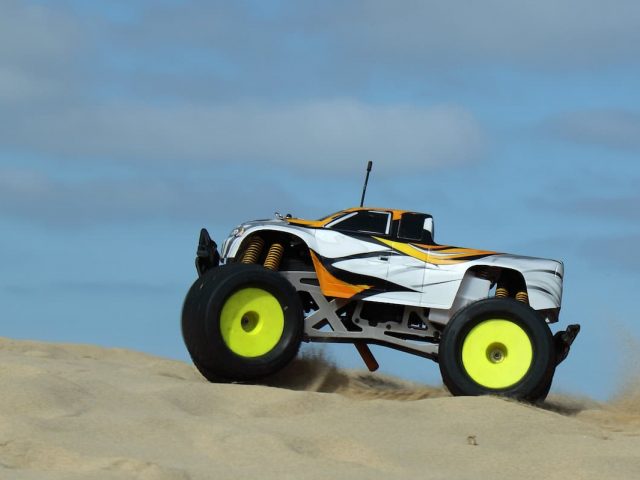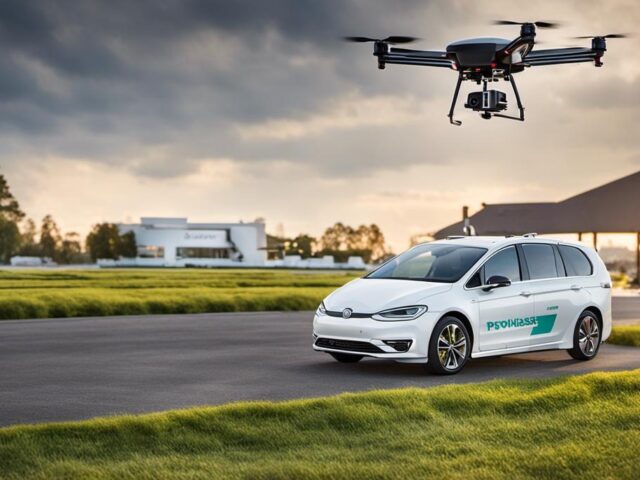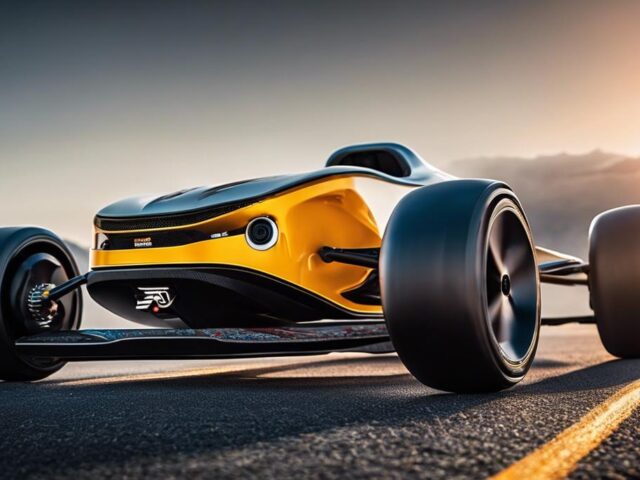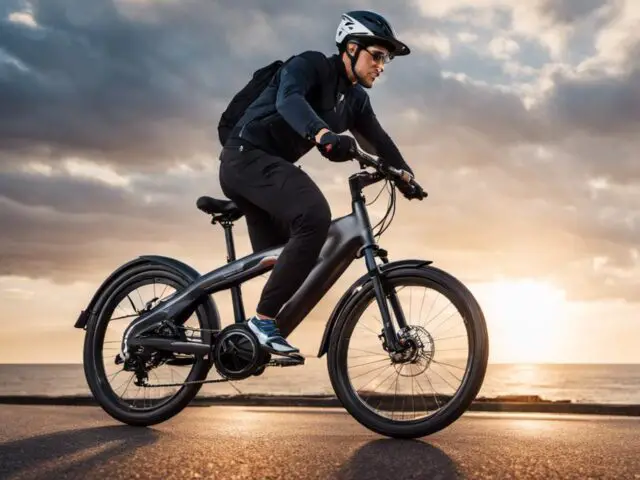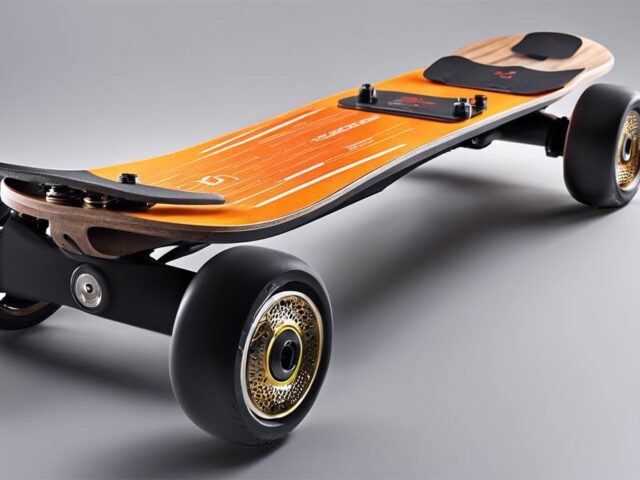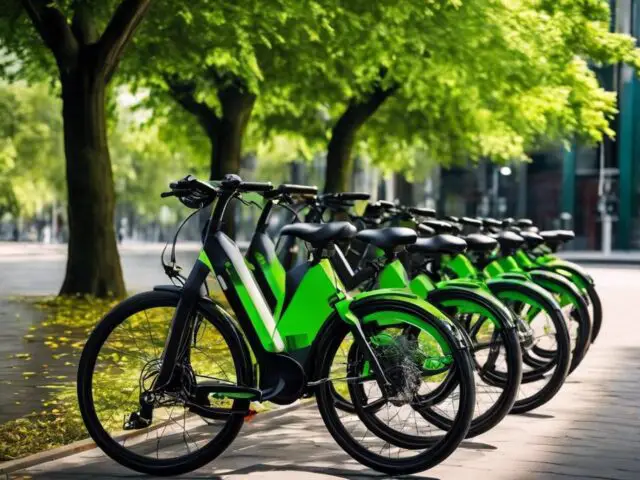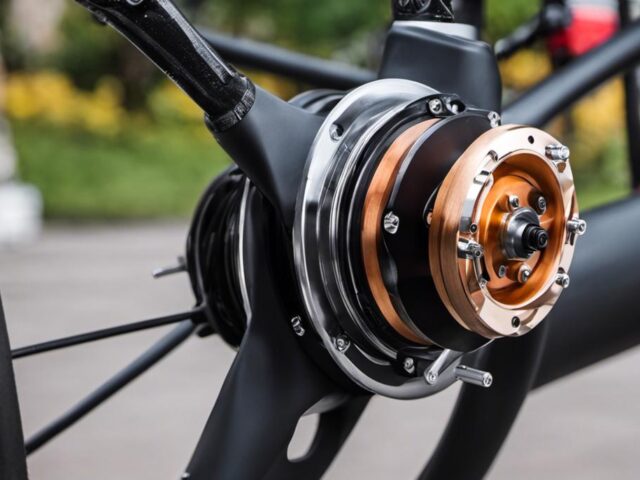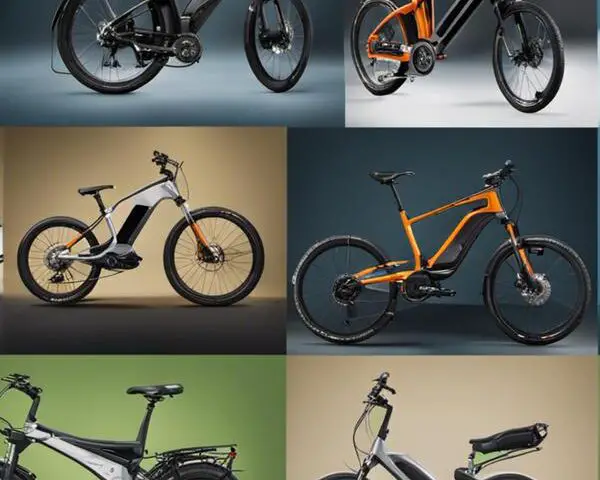Electric bikes, also known as e-bikes, have gained popularity in recent years due to their convenience and eco-friendly nature. But how do these bikes actually work? In this blog post, we’ll be exploring the science behind electric bikes in order to demystify them. We’ll be looking at what components make them run, the role of the battery, and the process of charging. By the end, you’ll have a better understanding and know the answer to “how do e-bikes work” and be able to make an informed decision about whether they’re right for you.
The Components of an Electric Bike

Electric bikes are a complex combination of various components that work together to create a smooth and efficient ride. Understanding the different parts of an electric bike is essential in comprehending how they function and how they differ from traditional bicycles.
The most critical component of an electric bike is the frame, which provides the structure and support for all other parts. Frames can be made from various materials such as aluminum, steel, or carbon fiber, each offering its own benefits in terms of strength, weight, and durability. The frame also houses the wiring and cables that connect the various components of the bike.
Next, we have the wheels, tires, and brakes. Electric bikes typically have larger and sturdier wheels compared to traditional bikes to handle the additional weight of the motor and battery. The tires are usually thicker and have deeper treads for better traction and stability. The brakes, whether they are disc brakes or traditional rim brakes, play a crucial role in ensuring the rider’s safety and controlling the bike’s speed.
Moving on to the drivetrain, electric bikes often use a chain and sprocket system to transfer power from the motor to the rear wheel. This system allows the rider to switch between different gear ratios, enabling them to pedal at different speeds and tackle various terrains. The chain and gears need to be regularly lubricated and maintained to ensure smooth operation.
The heart of an electric bike is the motor, which is responsible for providing additional power. There are different types of motors used in electric bikes, including hub motors and mid-drive motors. Hub motors are located in either the front or rear wheel hub and provide direct propulsion. Mid-drive motors, on the other hand, are positioned near the crankset and utilize the bike’s gears to enhance efficiency and performance. The motor is controlled by an electronic system that allows the rider to adjust the level of assistance and monitor various parameters such as speed and battery level.
Speaking of batteries, they are an essential component of electric bikes. Lithium-ion batteries are commonly used due to their high energy density, long lifespan, and lightweight. The battery’s capacity, measured in watt-hours (Wh), determines the bike’s range. Larger batteries typically provide more extended rides but also add weight to the bike. The battery is usually mounted on the frame or integrated into the downtube, providing easy access for charging.
To charge the battery, electric bikes are equipped with a charging port. Most electric bikes use standard wall outlets and come with a charger that can be plugged in at home, the office, or any convenient location. The charging time depends on the battery’s capacity and the charger’s output, ranging from a few hours to overnight. It is important to follow the manufacturer’s guidelines to ensure proper charging and maximize battery life.
The Motor and Battery System
The motor and battery system is the backbone of an electric bike, providing the power and energy needed for an effortless and efficient ride. Understanding how these components work together is essential in comprehending the capabilities and limitations of electric bikes.
The motor is responsible for providing the additional power that sets electric bikes apart from traditional bicycles. There are two main types of motors used in electric bikes: hub motors and mid-drive motors. Hub motors are located in either the front or rear wheel hub and provide direct propulsion. They are known for their simplicity and ease of use, making them a popular choice for casual riders. On the other hand, mid-drive motors are positioned near the crankset, which allows them to leverage the bike’s gears. This not only enhances efficiency but also provides a more natural riding experience, as the motor works in harmony with the rider’s pedaling.
Both types of motors are controlled by an electronic system, which allows the rider to adjust the level of assistance provided by the motor. This can usually be done through a handlebar-mounted display or controller. The electronic system also monitors various parameters such as speed, distance traveled, and battery level. Some advanced systems even offer features like regenerative braking, where the motor converts the bike’s kinetic energy into electrical energy to recharge the battery.
Speaking of the battery, it is a crucial component that determines the range and performance of an electric bike. Most electric bikes use lithium-ion batteries, which offer a high energy density, long lifespan, and lightweight. The battery’s capacity is measured in watt-hours (Wh) and determines how far the bike can go on a single charge. Larger batteries generally provide a longer range but also add weight to the bike.
To ensure convenience, the battery is usually mounted on the frame or integrated into the downtube, allowing easy access for charging. Electric bikes are equipped with a charging port, which allows the battery to be charged using a standard wall outlet. Most bikes come with a charger that can be plugged in at home, the office, or any convenient location. The charging time varies depending on the battery’s capacity and the charger’s output, ranging from a few hours to overnight.
It is important to follow the manufacturer’s guidelines when charging the battery to ensure proper charging and maximize its lifespan. Overcharging or using incompatible chargers can damage the battery and reduce its overall capacity.
How Do E-Bikes Work: Pedal Assist System Explained
The pedal assist system (PAS) is a key feature of electric bikes that sets them apart from traditional bicycles. It enhances the riding experience by providing an extra boost of power when the rider pedals. This innovative technology has revolutionized cycling, making it easier and more enjoyable for people of all fitness levels.
The pedal assist system, also known as PAS, works by sensing the rider’s pedaling motion and automatically engaging the motor to provide assistance. When the rider starts pedaling, sensors detect the movement and send a signal to the motor, activating it. The motor then kicks in, providing additional power to propel the bike forward.
The level of assistance can be adjusted to suit the rider’s preference and the riding conditions. Most electric bikes come with multiple levels of pedal assist, typically ranging from low to high. In low-assist mode, the motor provides a gentle boost, making it easier to pedal uphill or against a headwind. In high-assist mode, the motor delivers a stronger boost, allowing the rider to maintain a higher speed with less effort.
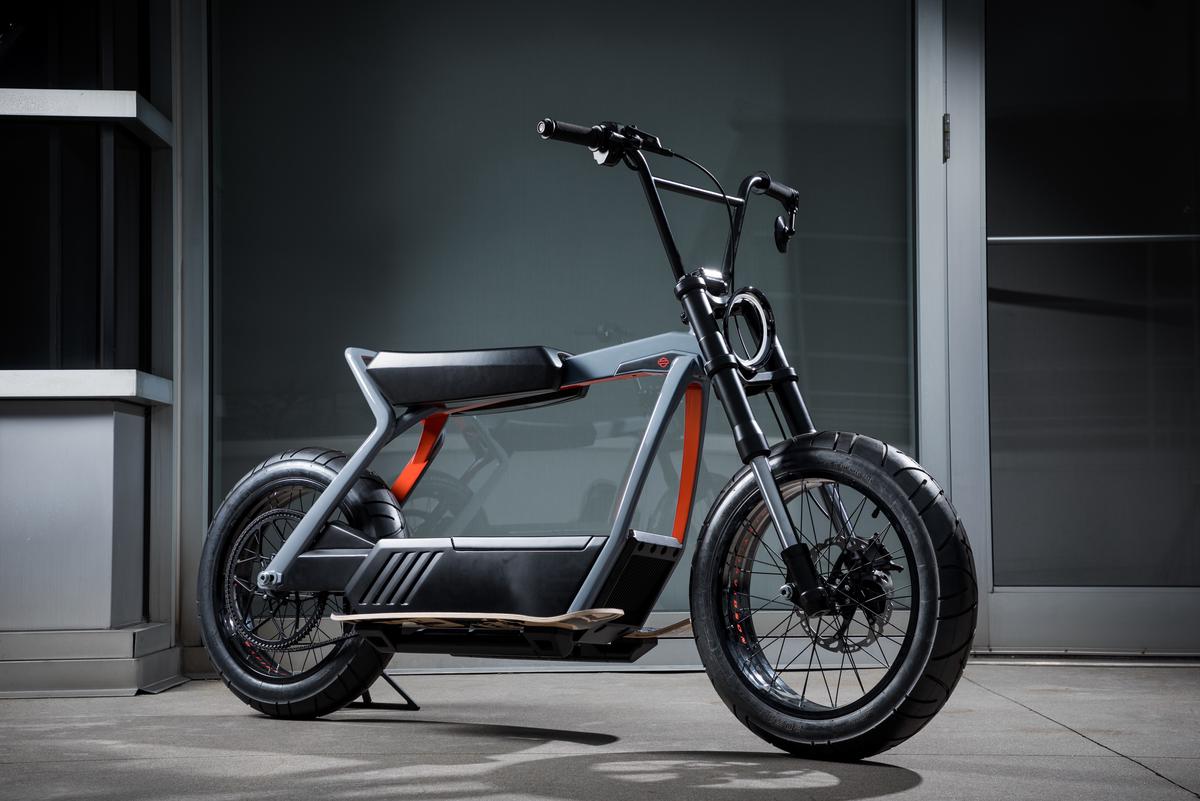
The pedal assist system works in harmony with the rider’s pedaling, amplifying their power rather than replacing it. It gives riders the ability to tackle challenging terrains, go further distances, and ride at higher speeds with less fatigue. It’s like having a constant tailwind at your back, making every ride feel effortless.
One of the key advantages of the pedal assist system is that it provides a more natural and intuitive riding experience. The motor responds to the rider’s pedaling input, adjusting the level of assistance accordingly. This means that the rider remains in control and can still get a good workout if desired. The pedal assist system simply enhances their pedaling power, allowing them to go faster and farther than they could on a traditional bike.
In addition to the physical benefits, the pedal assist system also offers environmental advantages. By making it easier and more enjoyable to ride, electric bikes encourage people to choose cycling over other modes of transportation, such as cars. This helps reduce traffic congestion and air pollution, making our cities cleaner and greener.
Overall, the pedal assist system is a game-changer in the world of cycling. It allows riders to enjoy the benefits of electric power while still getting exercise and staying active. Whether you’re a seasoned cyclist looking to extend your range or a casual rider seeking a fun and efficient way to get around, electric bikes with pedal assist are a fantastic option. They offer the best of both worlds – the joy of cycling with a boost of power.
Understanding Regenerative Braking
Understanding Regenerative Braking is a crucial aspect of comprehending how electric bikes work and how they differ from traditional bicycles. Regenerative braking is an innovative technology that allows electric bikes to convert kinetic energy into electrical energy, providing various benefits for both the rider and the bike itself.
So how does regenerative braking work? When you ride an electric bike and apply the brakes, instead of the energy being wasted as heat, the motor switches to generator mode. As the wheels slow down, the kinetic energy is harnessed and converted into electrical energy, which is then stored in the battery for later use. This process is made possible by the motor’s ability to reverse its operation and act as a generator.
Regenerative braking offers several advantages. Firstly, it helps to increase the overall efficiency of the bike. By recovering and storing energy that would have been lost during braking, regenerative braking enables the bike to go further on a single charge. This is particularly useful when riding in hilly or stop-and-go traffic conditions, as the energy recovered during braking can be used to provide additional power for accelerating or maintaining speed.
Another benefit of regenerative braking is the potential to extend the lifespan of the battery. By reducing the strain on the battery and minimizing the number of times it needs to be charged, regenerative braking can help prolong its overall lifespan. This is especially important considering that batteries are one of the most expensive components of an electric bike and will eventually need to be replaced.
Regenerative braking also offers a more comfortable and intuitive riding experience. When traditional brakes are applied, there can be a sudden jolt or jerk that can be uncomfortable for the rider. However, with regenerative braking, the bike gradually slows down, resulting in a smoother and more controlled stop. This can be particularly beneficial when riding on wet or slippery surfaces, as regenerative braking helps to maintain stability and prevent skidding.
It is important to note that regenerative braking is not a substitute for traditional brakes. While it can help to slow down the bike and recover energy, it does not provide the same level of stopping power as conventional brakes. Therefore, it is crucial to use the brakes appropriately and in conjunction with regenerative braking for optimal safety.
Overall, regenerative braking is an exciting feature of electric bikes that offers numerous benefits. It helps to increase the efficiency of the bike, extend the battery’s lifespan, and provides a more comfortable and intuitive riding experience. While it may not completely replace traditional brakes, it is a valuable addition to the electric bike’s repertoire of features. As electric bike technology continues to evolve, we can expect further advancements in regenerative braking systems, making electric bikes even more efficient and sustainable.
Types of Electric Bikes and Their Features
Electric bikes come in various types and styles, each designed to cater to different riding preferences and needs. Understanding the different types of electric bikes and their features can help you make an informed decision when choosing the right one for you. Let’s explore some of the most common types of electric bikes and the features they offer.
- City/Commuter Electric Bikes: City or commuter electric bikes are designed for urban environments and daily commuting. They typically have a comfortable upright riding position, wide tires for stability, and integrated lights for increased visibility. These bikes often come with features such as fenders and racks for carrying groceries or commuting essentials. They are perfect for navigating busy city streets and making your daily commute a breeze.
- Mountain Electric Bikes: Mountain electric bikes, also known as eMTBs, are built for off-road adventures and tackling rugged terrains. These bikes have durable frames, powerful motors, and wide tires with aggressive tread patterns for optimal traction. They often come equipped with suspension systems to absorb shocks and bumps, providing a smooth and comfortable ride on uneven trails. Mountain e-bikes are perfect for outdoor enthusiasts looking to explore nature and conquer challenging trails.
- Folding Electric Bikes: Folding electric bikes are compact and versatile, ideal for those with limited storage space or the need for portability. These bikes can be easily folded and carried onto public transportation or stored in small spaces. They often have smaller wheels and lighter frames, making them easy to maneuver in crowded areas. Despite their compact size, folding e-bikes still offer a comfortable and efficient ride for urban commuting or recreational use.
- Road Electric Bikes: Road electric bikes, also known as e-bikes or electric road bikes, are designed for speed and long-distance riding. These bikes have lightweight frames, sleek designs, and narrow tires with low rolling resistance. They are equipped with powerful motors that assist the rider in achieving higher speeds and maintaining a consistent pace. Road e-bikes are perfect for fitness enthusiasts or those who enjoy long rides on paved roads.
- Cargo Electric Bikes: Cargo electric bikes are specially designed for carrying heavy loads and transporting goods. These bikes have sturdy frames, long wheelbases, and powerful motors to handle the additional weight. They often come with large cargo racks or specialized cargo compartments to accommodate groceries, packages, or even children. Cargo e-bikes are an eco-friendly alternative to traditional delivery vehicles and are ideal for businesses or individuals who need to transport goods efficiently.
- Fat Tire Electric Bikes: Fat tire electric bikes, as the name suggests, have wide and thick tires that provide excellent stability and traction on various terrains, including snow, sand, or gravel. These bikes often come with powerful motors and robust frames to handle the extra weight. Fat tire e-bikes offer a smooth and comfortable ride, making them popular for outdoor adventures or beach cruising.
- Electric Trikes: Electric trikes, also known as electric tricycles, are three-wheeled bikes that provide stability and balance, making them suitable for riders who have difficulty balancing on two wheels.
In conclusion, an electric bike functions by utilizing both human and electric motor support. Sensors and a controller, which control how much power is transferred from the battery to the motor, control this assistance. The end result is a more effortless and effective riding experience that enables riders to travel further, climb hills with ease, and exert less effort either cycling for fun or commuting.
Helpful Links
For all your RC Questions, Click HERE
If you are interested in RC cars and trucks, RC World has you covered.
For RC boats and watercraft, check these articles out.
For all your RC Airborne endeavors, we have everything you need.
How a Radio Controlled Car Works (Servos & Transmitters)
Before you start driving your radio-controlled car, it’s helpful to know how it works. Radio-controlled cars work by transmitting electromagnetic frequencies to a circuit board. This information is…
Unfolding the Revolution: How Drone Delivery Works
In today’s rapidly advancing technological landscape, drone delivery is emerging as a breakthrough in the realm of logistics and supply chains. Employing sophisticated software, artificial intelligence (AI), GPS,…
Safe Electric Skateboard Rides for Kids
Choosing the right electric skateboard for your child involves more than just picking out a cool design. It’s about finding a balance between fun and safety, ensuring that…
Dual Motors: Electric Skateboard Power
The electrifying world of electric skateboards is evolving at a breathtaking pace, and the quest for heightened performance has led to the emergence of dual motor systems as…
Health Benefits of E-bikes: Improve Your Physical and Mental Well-being
Are you looking for a fun and efficient way to stay active and improve your overall health? Look no further than the world of e-bikes. These electric-powered bicycles…
Personalize Your E-Skate Experience
Electric skateboarding isn’t just a thrilling mode of transportation; it’s a craft that marries technology with the time-honored tradition of personal expression. By understanding the intricate dance of…
E-Bike Lifecycle: Reduce Carbon Emissions
In an age where climate change looms large and the quest for sustainable living becomes increasingly pressing, electric bicycles (e-bikes) emerge as a beacon of hope in the…
E-Bike Motor Types: A Comprehensive Breakdown
Electric bikes, also known as e-bikes, have become increasingly popular over the years due to their convenience and eco-friendliness. One of the key components of an e-bike is…
Mastering E-Bike Power Systems: Your Comprehensive Guide
E-bikes, or electric bicycles, have become increasingly popular in recent years as a mode of transportation and a recreational activity. With their ability to assist riders in pedaling…

